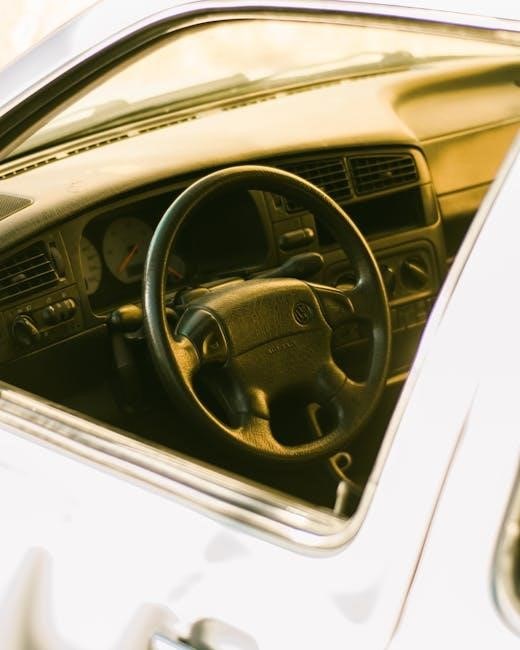Cars equipped with all-wheel drive (AWD) and manual transmission offer a rare combination of traction, control, and driving engagement, appealing to enthusiasts seeking both performance and versatility.
What is All-Wheel Drive (AWD)?
All-Wheel Drive (AWD) is a system that automatically distributes power to all four wheels, enhancing traction, stability, and control, particularly on slippery or uneven surfaces.
How AWD Works
All-Wheel Drive (AWD) operates by automatically distributing engine power to all four wheels, optimizing traction and stability. Advanced systems detect wheel slippage and transfer torque to wheels with better grip, ensuring improved control on various surfaces. Unlike part-time systems, AWD engages all wheels simultaneously, providing consistent performance without driver input. This seamless power distribution enhances handling in both dry and slippery conditions, making it ideal for diverse driving scenarios.
Benefits of AWD
All-Wheel Drive (AWD) enhances vehicle stability and control, particularly on uneven or slippery surfaces. By providing power to all four wheels, AWD improves traction, reducing the risk of skidding. This system is especially beneficial in snowy, rainy, or off-road conditions, offering better grip and confidence behind the wheel. Additionally, AWD can improve towing capacity and overall driving safety. Its ability to adapt to varying terrain makes it a versatile choice for drivers seeking performance and reliability in diverse environments.
What is a Manual Transmission?
A manual transmission, or “stick shift,” requires drivers to manually change gears using a clutch pedal and gearshift, offering control over the vehicle’s speed and torque.
How Manual Transmission Works
A manual transmission operates by requiring the driver to physically change gears using a clutch pedal and gearshift. The clutch pedal disengages the engine from the transmission, allowing the driver to shift gears smoothly. The gearshift, connected to the transmission, selects the desired gear ratio. As the driver presses the clutch and moves the gearshift, the transmission’s internal components (like synchromesh) ensure gears mesh properly. This mechanical process provides direct control over the vehicle’s speed and torque, engaging the driver in the driving experience.
Advantages of Manual Transmission
Manual transmissions offer several advantages, including better fuel efficiency, lower purchase costs, and enhanced driver engagement. They provide precise control over gear shifts, which can improve performance and reduce wear on the drivetrain. Additionally, manual transmissions are typically lighter and require less complex engineering than automatics. This simplicity often results in lower maintenance costs. For drivers who enjoy an active role in driving, especially in performance or off-road scenarios, a manual transmission paired with AWD can deliver a more rewarding and connected driving experience.

Benefits of Combining AWD and Manual Transmission
Combining AWD and manual transmission offers enhanced traction, precise control, and improved fuel efficiency. It provides a more engaging and cost-effective driving experience, perfect for diverse conditions.
Enhanced Traction and Control
Cars with AWD and manual transmission deliver superior traction by sending power to all wheels, optimizing grip on slippery surfaces and during sharp turns. The manual transmission allows precise control over torque distribution, enabling drivers to adapt to varying road conditions; This combination minimizes wheelspin and maximizes stability, especially on uneven terrain. The direct connection of a manual gearbox enhances driver feedback, making it easier to manage power delivery. Together, AWD and manual transmission provide a confident and responsive driving experience, ideal for both paved roads and off-road adventures.
Improved Fuel Efficiency
Cars with AWD and manual transmission can achieve better fuel efficiency compared to automatic counterparts. Manual transmissions typically weigh less and have fewer parasitic losses, contributing to lower fuel consumption. AWD systems, while adding complexity, often operate in two-wheel-drive mode under normal conditions, minimizing energy use. This combination allows drivers to optimize power delivery, reducing unnecessary fuel burn. Additionally, the control offered by a manual gearbox enables drivers to shift strategically, further enhancing mileage in both city and highway driving scenarios.
Cost-Effectiveness
Cars with AWD and manual transmission often offer a cost-effective solution for drivers seeking versatility and performance. Manual transmissions are generally more affordable to purchase and maintain than automatics, as they have fewer components. Additionally, AWD systems can reduce the need for costly repairs by preventing accidents through improved traction. While AWD adds complexity, pairing it with a manual gearbox often results in lower insurance costs and better fuel economy, making these vehicles a practical choice for budget-conscious enthusiasts who value both capability and savings.
Driving Experience
Cars with AWD and manual transmission deliver a unique driving experience that combines precision and control. The manual gearbox allows drivers to engage fully with the vehicle, offering a more connected feel. AWD enhances stability and grip, making cornering and acceleration smoother. This combination appeals to enthusiasts who value both performance and the joy of driving. Whether on paved roads or challenging terrain, the blend of mechanical interaction and all-wheel traction creates a dynamic and rewarding experience that fosters a deeper connection between driver and car.

History of AWD and Manual Transmission
All-wheel drive (AWD) and manual transmissions have evolved separately, with AWD tracing back to early 20th-century innovations and manuals originating in the 19th century, converging in modern vehicles like Subaru and Audi models, offering refined performance and control over decades.
Early Developments
Early developments of AWD and manual transmission began in the late 19th and early 20th centuries. AWD systems were first used in military vehicles and early racing cars for improved traction. Ferdinand Porsche’s 1900 Lohner-Porsche Mixte Hybrid was one of the first AWD vehicles. Manual transmissions emerged in the 19th century, with the first practical versions appearing in the early 1900s. These systems were refined over decades, eventually combining in vehicles like the Subaru Impreza and Audi Quattro, which popularized the AWD and manual combination for performance and control.
Modern Advancements
Modern advancements in AWD and manual transmission systems focus on optimization and integration. Contemporary AWD systems now feature electronic controls, enabling real-time torque distribution for improved efficiency and traction. Manual transmissions have evolved with lighter materials and precise gear ratios, enhancing driver engagement and performance. Dual-clutch transmissions and hybrid systems are also being explored to combine the benefits of manual control with modern automation. These innovations ensure that AWD and manual transmission vehicles remain relevant, blending tradition with cutting-edge technology for enthusiasts and practical drivers alike.
Top Models with AWD and Manual Transmission
Subaru Impreza WRX, Audi Quattro models, and the Mitsubishi Lancer Evolution are standout options, offering a blend of performance, traction, and driver engagement in AWD manual setups.
Economy Cars
Economy cars with AWD and manual transmission are rare but practical, offering affordability and traction. Models like the Subaru Impreza and Crosstrek provide excellent fuel efficiency, durable design, and engaging driving experiences, making them ideal for budget-conscious buyers seeking versatility. These cars balance performance with cost-effectiveness, ensuring reliability without compromising on features. They are perfect for daily commuting and light off-road adventures, delivering value and functionality in a compact package.
Luxury and Sports Sedans
Luxury and sports sedans with AWD and manual transmission blend sophistication with exhilarating performance. Audi’s Quattro models and select BMW variants offer precise handling, premium interiors, and the thrill of manual shifting. These sedans cater to discerning drivers who value both power and refinement, delivering a driving experience that combines adrenaline with elegance. They are engineered for those who appreciate the art of driving, ensuring a perfect balance between luxury and sportiness.
SUVs and Off-Road Vehicles
SUVs and off-road vehicles with AWD and manual transmission are built for adventure and durability. Models like the Subaru Outback and certain Jeep variants offer rugged capabilities, enhanced traction, and precise control. These vehicles excel in challenging terrains, providing drivers with confidence and reliability. Their manual transmissions add a layer of driver engagement, making them ideal for off-road enthusiasts who value both performance and connection to the driving experience.
Maintenance Considerations
Regular servicing, fluid checks, and inspections of AWD components like differentials and drivetrain ensure optimal performance. Manual transmissions require consistent clutch care and timely replacement of worn parts.
AWD System Maintenance
Regular inspections of the AWD system are crucial to ensure optimal performance. Check for leaks in the drivetrain and differentials, and maintain proper fluid levels. Inspect the transfer case and axles for wear. Ensure all electronic sensors and actuators are functioning correctly. Avoid extreme driving conditions that may strain the system. Regular servicing by a certified mechanic is recommended to identify potential issues early. Always consult the owner’s manual for specific maintenance schedules tailored to your vehicle.
Manual Transmission Care
Proper maintenance of a manual transmission ensures smooth operation and longevity. Regularly check the transmission fluid level and top it off as needed using the recommended type. Inspect the clutch for wear and ensure it engages fully. Avoid riding the clutch, as this can damage the release bearing and pressure plate. Shift gears smoothly to reduce stress on synchronizer rings and bearings. Replace the fluid every 30,000 to 60,000 miles, depending on the manufacturer’s recommendations. Address any unusual noises or grinding promptly to prevent costly repairs.
Driving Tips for AWD and Manual Transmission
Master smooth acceleration and clutch control to maximize traction. Use lower gears for inclines and slippery surfaces. Avoid sudden shifts to maintain stability and control effectively.
Mastering the Clutch
Mastering the clutch is essential for smooth driving in AWD manual cars. Feather the clutch gently to avoid jerky starts. Use the “biting point” to transition smoothly. On inclines, press the clutch halfway and shift gears carefully. Avoid sudden shifts, as they can disrupt traction. Practice in low-traffic areas to refine your technique. Smooth clutch engagement enhances control, especially on slippery surfaces. Proper clutch management reduces wear and tear, ensuring long-term durability. Consistent practice will make clutch operation second nature, improving overall driving efficiency and enjoyment.
Navigating Different Terrains
Navigating various terrains in AWD manual cars requires adaptability; On snowy or icy roads, apply gentle throttle and avoid sudden shifts. For off-road excursions, use low gears and maintain steady momentum. In muddy conditions, reduce speed and avoid sharp turns. On uneven terrain, feather the clutch to maintain control. Always check tire pressure and tread for optimal grip. When driving uphill, shift to a lower gear for better traction. For downhill descents, use engine braking to maintain speed; Winter tires are recommended for icy conditions, even with AWD. Smooth transitions between surfaces ensure stability and safety. Practice in controlled environments to refine your skills.
Market Demand and Future Trends
Demand for AWD manual cars remains niche but steady, driven by enthusiasts seeking control and performance. Future trends may see increased interest in sport-oriented AWD manuals.
Current Market Trends
Currently, the market for cars with AWD and manual transmission is niche, with limited models available. Subaru and Audi dominate this segment, offering popular choices like the WRX and Quattro models. These vehicles attract enthusiasts who prioritize driving engagement and performance. However, the majority of modern AWD vehicles now come with automatic or CVT transmissions, reducing the availability of manual options. Despite this, there is a steady demand from driving purists and those seeking unique driving experiences, keeping the market active, albeit smaller compared to automatic counterparts.
Future Outlook
The future of cars with AWD and manual transmission appears challenging, as automakers increasingly favor automatic and CVT options. Declining demand for manual transmissions, coupled with the complexity of integrating AWD systems, may limit new models. However, niche markets and enthusiast communities are likely to sustain demand for these vehicles. While electrification dominates the industry, hybrid or electric AWD cars with manual transmissions could emerge, blending tradition with innovation. For now, this rare combination remains a specialty for driving purists and off-road enthusiasts, ensuring its survival, albeit in limited numbers.

Comparison with Other Drivetrains
Cars with AWD and manual transmission stand out against other drivetrains, offering unique advantages in traction and driver engagement compared to FWD or automatic transmissions.
AWD vs. 4WD
All-wheel drive (AWD) and four-wheel drive (4WD) systems both provide power to all wheels but differ in operation. AWD systems automatically distribute power between axles without driver input, often used in cars for improved traction on various surfaces. In contrast, 4WD typically requires manual activation, commonly found in off-road vehicles. While AWD offers seamless performance, 4WD provides maximum control in extreme conditions. Both systems enhance stability but cater to different driving needs and preferences.
Manual vs. Automatic Transmission
Manual and automatic transmissions cater to different driving preferences. Manual transmissions require driver engagement with a clutch and gearshift, offering precise control and fuel efficiency. Automatics provide convenience and ease, especially in stop-and-go traffic, but may lack the driving involvement some enthusiasts seek. While manuals are typically more cost-effective, modern automatics often match or exceed their efficiency. The choice between the two depends on lifestyle, driving conditions, and personal preference for either enhanced control or added comfort.

Lightweight Cars with AWD and Manual Transmission
Lightweight cars with AWD and manual transmission strike a balance between performance and efficiency. Models like the Subaru Impreza WRX or Mitsubishi Lancer Evolution combine compact designs with powerful engines, delivering agility and responsiveness. These vehicles often feature optimized drivetrains that minimize weight while maintaining traction, making them ideal for both daily driving and spirited adventures. Their lightweight construction enhances fuel economy without sacrificing the thrill of manual control, appealing to enthusiasts who value precision and driving engagement.
How to Inspect and Purchase
- Check the AWD system for wear and leaks, ensuring all components function properly.
- Test the manual transmission for smooth shifting and no grinding noises.
- Review maintenance records and look for any signs of neglect or repairs.
- Take a test drive on various terrains to assess performance and handling.
Things to Check
When inspecting a car with AWD and manual transmission, start with the AWD system: check for leaks, test 4WD functionality, and ensure all drivetrain components are intact. Examine the manual transmission for smooth shifting and clutch operation. Review maintenance records for regular servicing and verify the absence of major repairs. Inspect the tires for even wear, as uneven wear can indicate AWD issues. Finally, take a test drive to assess performance on both paved and unpaved surfaces, ensuring the car handles as expected in various conditions.
Test Drive Tips
When test driving a car with AWD and manual transmission, start on paved roads to assess smoothness and acceleration. Shift gears to ensure the clutch and transmission operate seamlessly. Test on rough terrain to evaluate AWD traction and stability. Accelerate uphill to check for drivetrain strain. If the vehicle has a part-time AWD system, engage it to test its functionality. Pay attention to any unusual noises or vibrations, which could indicate issues. Finally, drive in low-traction conditions to confirm the AWD system engages properly and maintains control.
Reliability and Durability
Cars with AWD and manual transmission are known for their robust engineering, offering long-term durability and reliability when properly maintained. Regular servicing ensures optimal performance and extends lifespan.
Factors Affecting Reliability
Several factors influence the reliability of cars with AWD and manual transmission. Regular maintenance of the AWD system, including fluid checks and component inspections, is crucial. The manual transmission’s clutch and gear synchronizers require proper use to avoid wear. Driving conditions, such as frequent off-road use or extreme weather, can also impact longevity. Additionally, the quality of manufacturer components and adherence to service schedules play significant roles in ensuring long-term reliability and performance of these vehicles.
Long-Term Durability
Cars with AWD and manual transmission often demonstrate excellent long-term durability when properly maintained. The robust design of AWD systems, paired with the simplicity of manual transmissions, can withstand years of use. However, components like the clutch and drivetrain may require occasional replacement. Regular servicing and avoidance of extreme stress on the systems further enhance durability. Many models, such as Subaru and Audi, are known for their longevity, making them reliable choices for drivers seeking a durable vehicle with both AWD and manual transmission capabilities.
Cars with AWD and manual transmission offer a unique blend of performance, control, and efficiency, catering to diverse driving needs. While their availability is limited, models like Subaru and Audi provide reliable options. Proper maintenance ensures longevity, making these vehicles a worthwhile investment for enthusiasts and practical drivers alike. As technology evolves, the future of AWD and manual transmission cars remains promising, balancing tradition with innovation to meet modern demands.
